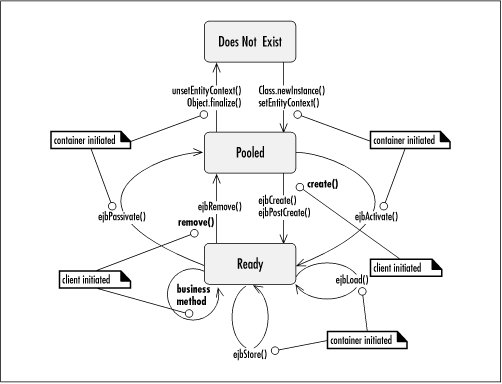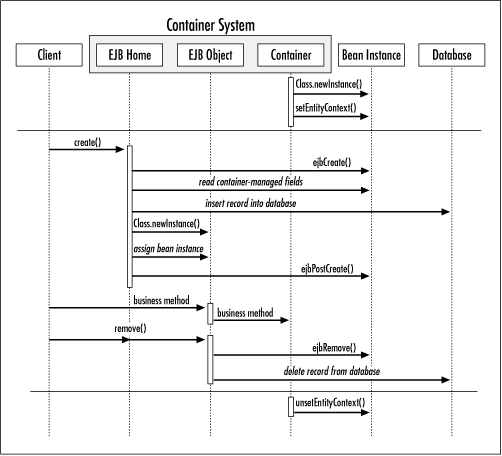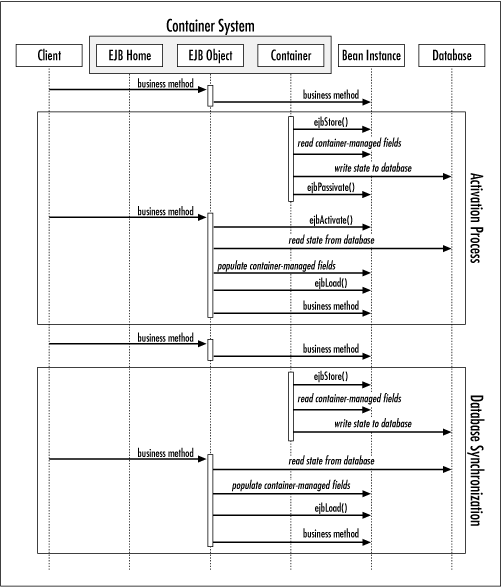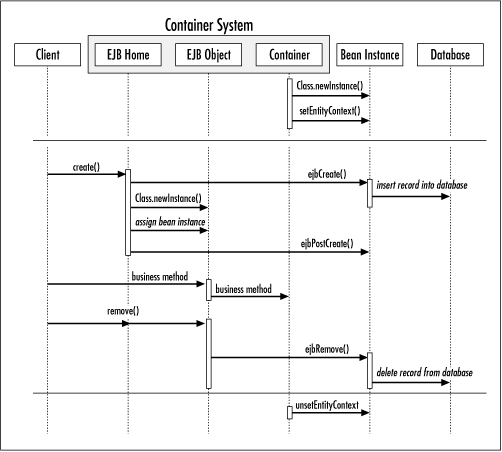 | Enterprise JavaBeans |  |

The appendix contains state and sequence diagrams for all the bean types discussed in this book: container-managed and bean-managed entity beans, and stateless and stateful session beans. Although standard UML is used in these diagrams, some extensions were required to model EJB runtime characteristics. In the state diagrams, for example, actions of the client and container are shown in the standard format; callback methods and class instantiation operations are shown as part of the transition event. The separation of client and container requires this simple extension.
In the sequence diagrams, container-provided classes such as the container itself, EJB object, and EJB home are shown as separate classes but are also boxed together. Messages sent from classes in the container system box are considered to be sent from the container system as a whole, not necessarily the specific container-provided class. This generalization is necessary because the container's interaction with the bean is characterized by these classes but will be different from one vendor's implementation to the next. The exact source of the message is immaterial, as long as you realize that the container system sent it.





Table B-1 and Table B-2 summarize the operations that an entity bean is allowed to perform in various stages of its life cycle.
|
Method |
Allowed Operations |
|---|---|
|
setEntityContext() unsetEntityContext() |
EntityContext methods:
JNDI ENC contexts:
|
|
ejbCreate() ejbFind() |
EntityContext methods:
JNDI ENC contexts:
|
|
ejbPostCreate() ejbLoad() ejbStore() ejbRemove() business methods |
EntityContext methods:
JNDI ENC contexts:
|
|
ejbActivate() ejbPassivate() |
EntityContext methods:
JNDI ENC contexts:
|
Note that entity beans in EJB 1.1 can never access the EJBContext.getUserTransaction() method, because entity beans are not allowed to manage their own transactions. Only session beans can access this method.
|
|
Allowed Operations |
|
|---|---|---|
|
Method |
Container-Managed Transactions |
Bean-Managed Transactions |
|
setEntityContext() unsetEntityContext() |
EntityContext methods:
|
EntityContext methods:
|
|
ejbCreate() ejbFind() |
EntityContext methods:
|
EntityContext methods:
|
|
ejbPostCreate() ejbLoad() ejbStore() ejbRemove() business methods |
EntityContext methods:
|
EntityContext methods:
|
|
ejbActivate() ejbPassivate() |
EntityContext methods:
|
EntityContext methods:
|

Copyright © 2001 O'Reilly & Associates. All rights reserved.